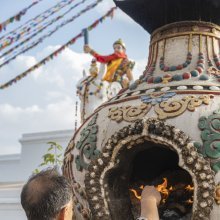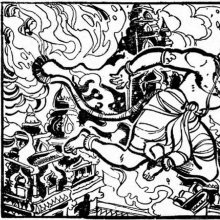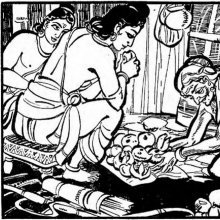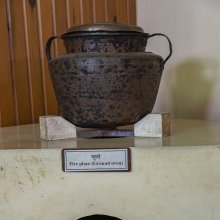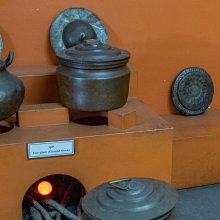Fire: 6 definitions
Introduction:
Fire means something in Buddhism, Pali, Hinduism, Sanskrit, the history of ancient India. If you want to know the exact meaning, history, etymology or English translation of this term then check out the descriptions on this page. Add your comment or reference to a book if you want to contribute to this summary article.
Images (photo gallery)
(+33 more images available)
In Hinduism
Yoga (school of philosophy)
Source: ORA: Amanaska (king of all yogas): A Critical Edition and Annotated Translation by Jason BirchFire refers to one of the “five elemental powers” and represents one of the various signs and paranormal powers (siddhi) experienced by the Yoga practicioner, according to the Amanaska Yoga treatise (presented in the form of a dialogue between Īśvara and Vāmadeva).—The last fifty-two verses of the Amanaska’s first chapter describe a temporal sequence of psychosomatic signs and paranormal powers (siddhi) brought about by absorption (laya). In the Amanaska, The five elemental powers are, [e.g., fire (tejas-tattva)], [...].

Yoga is originally considered a branch of Hindu philosophy (astika), but both ancient and modern Yoga combine the physical, mental and spiritual. Yoga teaches various physical techniques also known as āsanas (postures), used for various purposes (eg., meditation, contemplation, relaxation).
Shilpashastra (iconography)
Source: Shodhganga: Elements of Art and Architecture in the Trtiyakhanda of the Visnudharmottarapurana (shilpa)Fire is associated with Agni (Vahni), whose iconography is described in the Viṣṇudharmottarapurāṇa, an ancient Sanskrit text which (being encyclopedic in nature) deals with a variety of cultural topics such as arts, architecture, music, grammar and astronomy.—Vahni is the synonym of Agni. In the Viṣṇudharmottarapurāṇa the word vahni is used to denote the god Agni. According to the Śabdakalpadruma, Agni is the god who possesses fire in him as he is born from fire. In the agnisūkta of Ṛgveda, Agni is called as Aṅgiras. Thus it is clear that the Viṣṇudharmottarapurāṇa offers a great field of knowledge regarding the nuances of Indian art of Image making [e.g., fire] during 10th–11th century A.D.

Shilpashastra (शिल्पशास्त्र, śilpaśāstra) represents the ancient Indian science (shastra) of creative arts (shilpa) such as sculpture, iconography and painting. Closely related to Vastushastra (architecture), they often share the same literature.
General definition (in Hinduism)
Source: Shodhganga: Elements of Art and Architecture in the Trtiyakhanda of the Visnudharmottarapurana (h)Fire is used for conveying the offerings to the deities by making use of Fire altars.—The Hindu temples are designed for the purpose of making connection between man and the divine and to help the people to develop their spiritual knowledge and truth. From almost all accounts, it comes up that the origin of Hindu temples goes far back to those fire altars, which were used for conveying the offerings to the deities through fire, sacredly energized by chanting the holy mantras of the Vedic time. [...] In the Śatapathabrāhmaṇa it is stated that by worshiping fire in the Vedic age, the devotees or the sages obtained saṃvīd i.e., the entire earth and as because they were able to obtain this entire earth by it, therefore the, sacrificial ground is called vedī.
In Buddhism
Tibetan Buddhism (Vajrayana or tantric Buddhism)
Source: Google Books: The Crystal Mirror of Philosophical Systems1) Fire refers to the “Four Great Elements” which are known in Tibetan as 'byung ba chen po bzhi.—Accordingly, [while describing the history of philosophical systems in the holy land of India], [regarding the standpoint of the Lokāyatas]: [...] At the time of death, the body dissolves into the Four Great Elements [e.g., Fire], and the sense faculties dissolve into space; they are destroyed. Since body and mind are one substance, when the body is destroyed the mind is also destroyed, just as when the wall is destroyed its mural is also destroyed, and there is no transition from this life to a future life. Thus they deny both past and future lives, and so also completely deny liberation.
2) Fire refers to one of the “Five Elements” (Tibetan: 'byung ba lnga) in both the Indo-Tibetan tradition and the Chinese tradition.

Tibetan Buddhism includes schools such as Nyingma, Kadampa, Kagyu and Gelug. Their primary canon of literature is divided in two broad categories: The Kangyur, which consists of Buddha’s words, and the Tengyur, which includes commentaries from various sources. Esotericism and tantra techniques (vajrayāna) are collected indepently.
India history and geography
Source: Google Books: The Crystal Mirror of Philosophical Systems (h)Fire is known as “li” and represents one of the “Eight Bagua” which refers to the trigrams of the Classic of Changes; they are known in Tibetan as pā bkwa brgyad.—Accordingly, [while describing the non-Buddhist Chinese traditions and confucian divination]: [...] At the time of the first Huang monarch, King Fu Xi, there emerged from the great Huang He (Yellow River) in the province now called Henan, a dragon-horse, with a midsection like a horse and a head and tail like a dragon. On its back were the bagua or eight designs (trigrams) [e.g., li (fire)]. Seeing them, Fu Xi created the bagua emblems. He expanded the eight bagua to sixty-four [hexagrams] by combining the eight trigrams with each other and explained them in a text he composed called Lianshan. [...]

The history of India traces the identification of countries, villages, towns and other regions of India, as well as mythology, zoology, royal dynasties, rulers, tribes, local festivities and traditions and regional languages. Ancient India enjoyed religious freedom and encourages the path of Dharma, a concept common to Buddhism, Hinduism, and Jainism.
Languages of India and abroad
Nepali dictionary
Source: unoes: Nepali-English DictionaryFire is another spelling for फायर [phāyara].—n. fire (of pistols);
Nepali is the primary language of the Nepalese people counting almost 20 million native speakers. The country of Nepal is situated in the Himalaya mountain range to the north of India.
See also (Relevant definitions)
Starts with (+9): Fire altar, Fire birch, Fire bush, Fire cherry, Fire dragon, Fire Element, Fire God, Fire leaf, Fire lily, Fire oblation, Fire on the mountain, Fire plant, Fire sticks, Fire thorn, Fire-berry hawthorn, Fire-flame bush, Fire-thorn karree, Fire-worship, Fireball, Fireberry hawthorn.
Query error!
Full-text (+8521): Agni, Pancagni, Homa, Agnihotra, Agneya, Anala, Vahni, Arani, Pavaka, Jvalana, Agnyadhana, Dahana, Vaishvanara, Kunda, Garhapatya, Hutashana, Havana, Ahavaniya, Kalagni, Agnipravesha.
Relevant text
Search found 577 books and stories containing Fire, The fire; (plurals include: Fires, The fires). You can also click to the full overview containing English textual excerpts. Below are direct links for the most relevant articles:
Brahma Sutras (Nimbarka commentary) (by Roma Bose)
Brahma-Sūtra 3.3.50 (correct conclusion, end) < [Adhikaraṇa 20 - Sūtras 43-50]
Brahma-Sūtra 3.3.49 (correct conclusion, continued) < [Adhikaraṇa 20 - Sūtras 43-50]
Brahma-Sūtra 3.3.44 (prima facie view, 44-45) < [Adhikaraṇa 20 - Sūtras 43-50]
Manusmriti with the Commentary of Medhatithi (by Ganganatha Jha)
Verse 6.4 < [Section II - The Procedure to be adopted]
Verse 11.65 < [Section VI - Offences: their Classification]
Verse 6.9 < [Section III - Details of the Hermit’s Life]
Satapatha-brahmana (by Julius Eggeling)
Kanda IV, adhyaya 6, brahmana 8 < [Fourth Kanda]
Kanda II, adhyaya 4, brahmana 1 < [Second Kanda]
Kanda II, adhyaya 3, brahmana 3 < [Second Kanda]
Mahabharata (English) (by Kisari Mohan Ganguli)
Section CCXXI < [Markandeya-Samasya Parva]
Section CCXX < [Markandeya-Samasya Parva]
Section CXXXVII < [Tirtha-yatra Parva]
Bharadvaja-srauta-sutra (by C. G. Kashikar)
Baudhayana Dharmasutra (by Georg Bühler)
Related products
(+12 more products available)
